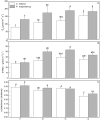Differential photosynthetic and morphological adaptations to low light affect depth distribution of two submersed macrophytes in lakes
- PMID: 27694880
- PMCID: PMC5046178
- DOI: 10.1038/srep34028
Differential photosynthetic and morphological adaptations to low light affect depth distribution of two submersed macrophytes in lakes
Abstract
To evaluate the relative importance of photosynthetic versus morphological adaptations of submersed macrophytes to low light intensity in lakes, rapid light curves (RLCs), morphological parameters, relative growth rate (RGR), clonal reproduction and abundance of two submersed macrophytes (Potamogeton maackianus and Vallisneria natans) were examined under 2.8%, 7.1%, 17.1% and 39.5% ambient light in a field and outdoor experimental study. The plants increased their initial slope of RLCs (α) and decreased their minimum saturating irradiance (Ek) and maximum relative electron transport rate (ETRm) of RLCs under low light stress, but V. natans was more sensitive in RLCs than P. maackianus. Accordingly, the RGR, plant height and abundance of P. maackianus were higher in the high light regimes (shallow water) but lower in the low light regimes than those of V. natans. At the 2.8% ambient light, V. natans produced ramets and thus fulfilled its population expansion, in contrast to P. maackianus. The results revealed that P. maackianus as a canopy-former mainly elongated its shoot length towards the water surface to compensate for the low light conditions, however, it became limited in severe low light stress conditions. V. natans as a rosette adapted to low light stress mainly through photosynthetic adjustments and superior to severely low light than shoot elongation.
Figures







References
-
- Barko J. W., Adams M. S. & Clesceri N. L. Environmental factors and their consideration in the management of submersed aquatic vegetation: a review. J. Aquat. Plant Manage. 24, 1–10 (1986).
-
- Philip G. L., Eminson D. & Moss B. A mechanism to account for macrophyte decline in progressively eutrophicated freshwaters. Aquat. Bot. 4, 103–126 (1978).
-
- Arts G. H. P. Deterioration of Atlantic soft water macrophyte communities by acidification, eutrophication and alkalinisation. Aquat. Bot. 73, 373–393 (2002).
-
- Hautier Y., Niklaus P. A. & Hector A. Competition for light causes plant biodiversity loss after eutrophication. Science 324, 636–638 (2009). - PubMed
Publication types
LinkOut - more resources
Full Text Sources
Other Literature Sources
Research Materials

